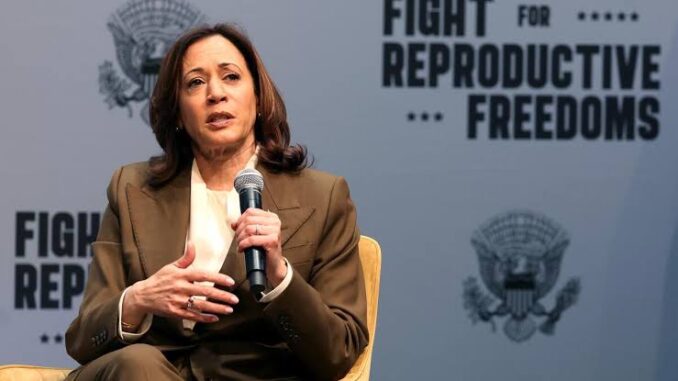
Kamala Harris’ Secret Power Play After the Election That Could Reshape Her Legacy
As the dust settles after the 2024 election, the political world is buzzing with speculation about Kamala Harris’ next moves. While most expected her to take a backseat after the hard-fought battle for the White House, a quiet but powerful shift is unfolding within the vice president’s inner circle. Reports are emerging that Kamala Harris is not just planning her next steps—she is orchestrating a seismic shift that could transform her political legacy and the Democratic Party’s future.
The significance of what’s happening behind the scenes cannot be overstated. For a long time, Harris has been seen as a figure caught in the shadow of President Joe Biden. As the first female vice president, the first woman of color in the role, and a trailblazer in many ways, her tenure has been marked by both historic triumphs and high expectations. Yet, despite the symbolic victories of her time in office, many critics and political insiders have felt that Harris’ true potential remained untapped.
Now, reports are revealing that she’s quietly maneuvering for a more influential position within the party. According to multiple sources close to the vice president, Harris is positioning herself to become the face of a new, more progressive and dynamic wing of the Democratic Party—one that could redefine the future of American politics. But this transition isn’t as straightforward as it seems.
A Changing Role in the Party
Kamala Harris has always been known for her ability to navigate complex political dynamics. As a senator from California, she built a reputation for her sharp legal mind, her commitment to justice, and her willingness to challenge the status quo. However, as vice president, her role has often been more symbolic and reactionary. She has largely focused on domestic and international issues assigned to her by the president, rather than carving out a distinctive, independent platform.
But sources indicate that Harris is ready to break free of this mold. A key part of her post-election strategy involves aligning with the rising stars of the party, many of whom are pushing for policies that directly challenge the establishment. From climate action to healthcare reform, Harris is reportedly ready to throw her weight behind a series of bold initiatives that could not only enhance her political influence but also solidify her standing as the future of the Democratic Party.
The Role of Progressive Allies
One of the most intriguing aspects of Harris’ new political strategy is her alliance with a growing group of progressive lawmakers and activists. After the election, Harris began meeting regularly with several influential members of the House and Senate, including rising stars like Alexandria Ocasio-Cortez and Ilhan Omar, as well as veteran progressives like Bernie Sanders and Elizabeth Warren. Together, they are reportedly crafting a vision for the future of the party—one that emphasizes bold economic reforms, aggressive climate action, and expanding civil rights protections.
While some might view this as a pragmatic political move to broaden her base, insiders suggest that Harris sees this as an opportunity to fundamentally alter her political legacy. Historically, vice presidents have often faced difficulty transitioning to independent power once the presidency shifts. But by aligning with the progressive wing, Harris is making a calculated decision to align herself with the future of the party, rather than the status quo that has often defined the Biden administration.
What is most striking about this new alliance is Harris’ ability to unite seemingly disparate factions within the party. While Biden’s presidency has often been described as a balancing act between moderates and progressives, Harris is now in a position to bridge this divide. She understands that the future of the Democratic Party will not be shaped by incremental change, but by bold, visionary ideas—and she’s ready to champion them.
The Shift in Public Perception
Perhaps the most significant consequence of Harris’ strategic shift is the potential for a dramatic change in public perception. While she has long been a polarizing figure, especially among conservative voters, Harris’ progressive turn could help her build broader appeal, especially among younger voters who have become disillusioned with the political establishment. By aligning herself with the bold, transformative ideas that resonate with the new generation, Harris could not only solidify her position as the leader of the next phase of the Democratic Party but also as a champion of progressive ideals.
Public perception of Harris has always been a double-edged sword. Some voters see her as a powerful symbol of progress—a woman of color who rose to the highest office in the land, shattering glass ceilings in the process. But others have viewed her through a more critical lens, particularly with her record as a prosecutor and her perceived role in the Obama administration’s policies that some progressives consider too moderate.
However, by embracing a more progressive agenda in her post-election strategy, Harris has the chance to redefine her image. It’s no longer just about breaking barriers—it’s about delivering on the promises of equality, justice, and economic opportunity that many Americans have been waiting for.
The Political Fallout
Of course, Harris’ power play isn’t without its risks. The Democratic Party is known for its internal divisions, and by aligning herself so closely with the progressive wing, she risks alienating moderates who are key to winning national elections. The fear is that the party could fracture further, weakening its chances in future elections if Harris pushes too hard for policies that alienate centrist voters.
Moreover, there are those within the party who will see her move as an attempt to position herself for a presidential run in 2028, potentially drawing the ire of those who prefer a different type of leader to carry the party forward. If she’s perceived as positioning herself too aggressively for the future, Harris could face backlash that undermines her efforts to unite the party.
However, the rewards of this risk could be monumental. If Harris succeeds in creating a unified, progressive agenda that speaks to the concerns of a diverse and younger electorate, she could reshape the Democratic Party for decades to come. And if she plays her cards right, she could also set herself up as the uncontested leader of that new era, commanding both political power and public admiration.
Conclusion
Kamala Harris’ post-election power play could very well reshape her legacy and the future of the Democratic Party. By aligning with the progressive wing, she has positioned herself as a leader of change, ready to take on the establishment and challenge the status quo. Whether this shift will lead to long-term success or fracture the party remains to be seen, but one thing is clear: Harris is no longer content to remain in the background. She’s ready to make her mark as a transformative leader, shaping the future of American politics in ways no one expected.



Be the first to comment